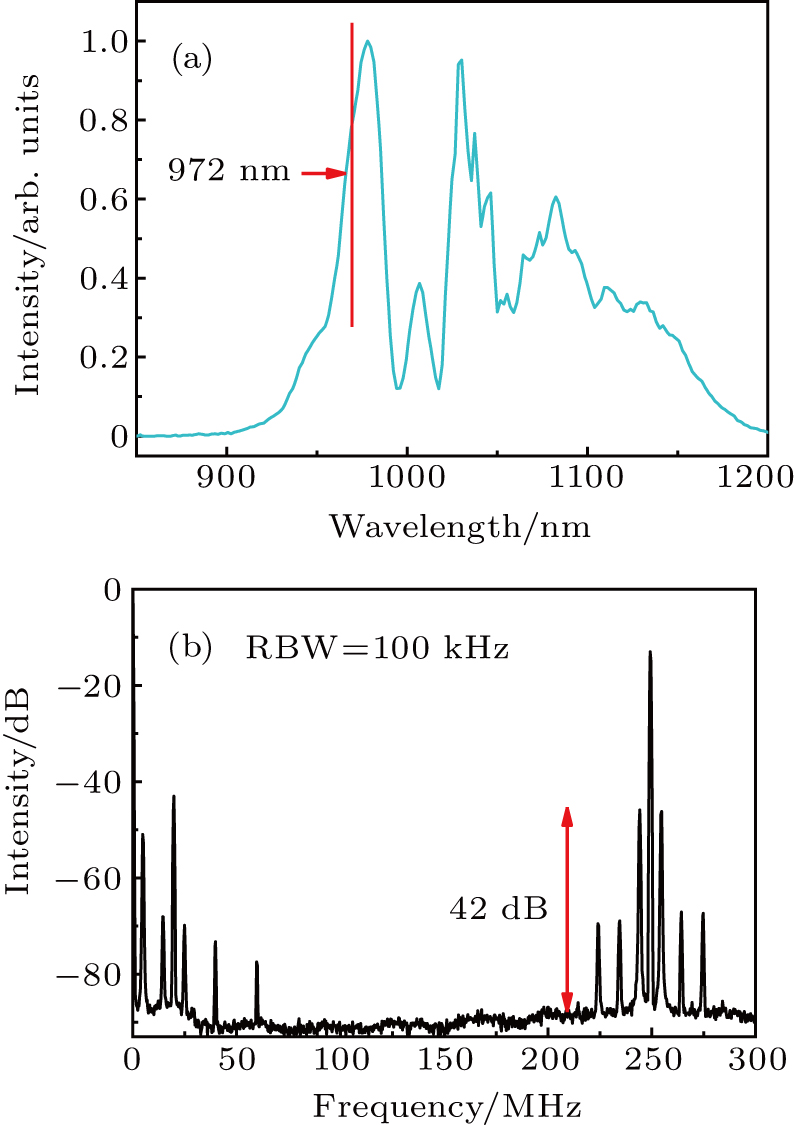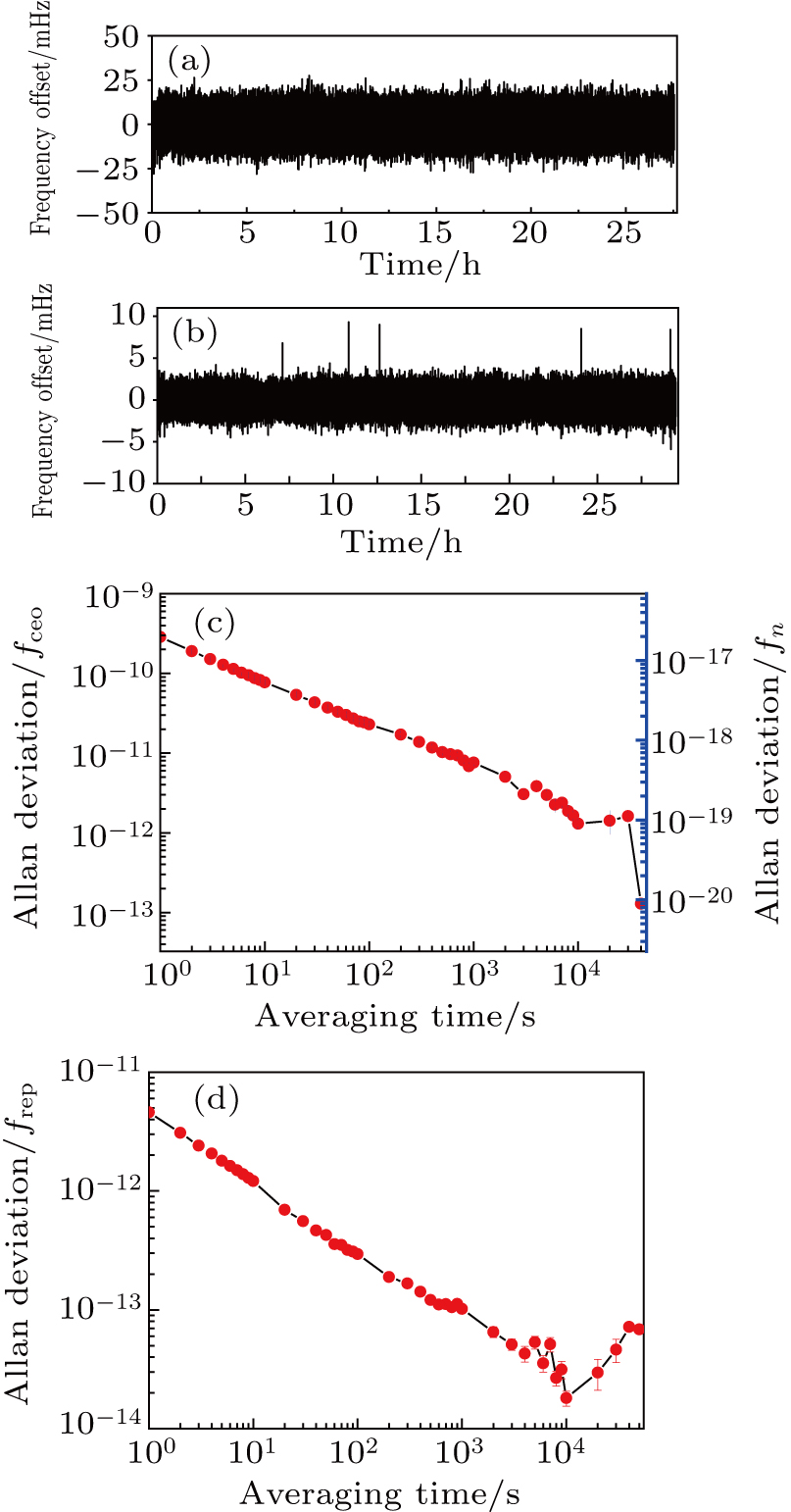† Corresponding author. E-mail:
Project supported by the Strategic Priority Research Program of the Chinese Academy of Sciences (Grant Nos. XDA1502040404 and XDB21010400) and the National Natural Science Foundation of China (Grant Nos. 91850209 and 11774234).
We present a fully stabilized Yb-fiber frequency comb locked to a microwave standard and an optical reference separately. The carrier-envelope offset frequency is generated by a standard f –2f interferometer with 40 dB signal-to-noise ratio. The offset frequency and the repetition rate are stabilized simultaneously to the radio frequency reference for more than 30 hours, and the fractional Allan deviation of the comb is the same as the microwave standard of 10−12 at 1 s. Alternatively, the comb is locked to an ultra-stable optical reference at 972 nm using an intracavity electro-optic modulator, exhibiting a residual integrated phase noise of 458 mrad (1 Hz–10 MHz) and an in-loop tracking stability of 1.77 × 10−18 at 1 s, which is significantly raised by six orders comparing to the case locked to the microwave frequency standard.
Low-noise optical frequency combs are desired for many scientific applications, such as optical atomic clocks, high-resolution spectroscopy, fundamental physical constant measurement, and attosecond science.[1–6] Over the past two decades, several strategies were used to build optical frequency combs, such as Ti:sapphire laser combs, all-solid-state laser combs, fiber-laser combs, electro-optic combs, and microresonator combs.[7–11] In particular, fiber-laser frequency combs have become one of the most widely used optical frequency combs due to their robustness, low-cost, and long-term stability. Previous works have shown the great potential of fiber-laser optical frequency combs.[12–14] In terms of average power, a fiber-laser comb with submillihertz linewidth and higher than 10 W average power was achieved based on an Yb-fiber system in 2008[15] and then the average power was increased to 80 W employing the linear chirped-pulse amplification.[16] Several effective noise suppression measures have been implemented, promoting the fiber-laser comb to the same noise level as that of the Ti:sapphire laser comb.[17,18] Moreover, with all-fiber structure and compact design, the fiber frequency comb can operate outside the well-controlled optical laboratory or even in the space environment for a long time.[19,20]
Femtosecond mode-locked fiber lasers are the key element of the fiber optical frequency comb and directly affect the stability and accuracy of the total system. Early experiments indicated that fiber lasers have large phase noise introduced by the high gain high loss cavity dynamics and high nonlinearity during the propagation in the fiber.[21] Despite daunting technical challenges, the past decade has witnessed remarkable progress in different fiber mode-locking schemes.[12,22] Among these laser sources, the fiber laser using nonlinear polarization evolution (NPE) technique is a good choice due to its broader spectra output and low phase noise generation. With the help of intracavity grating pairs, zero net cavity group-delay dispersion (GDD) could be easily realized for getting the lowest noise and the narrowest linewidth for the carrier-envelope offset (CEO) frequency (fceo).[23]
Frequency combs have millions of optical modes, whose frequencies can be determined by the equation in the frequency domain: fn = n frep + fceo, where n is the integer of mode number. The repetition rate, frep, represents the spacing between the comb teeth. The carrier-envelope offset frequency, fceo, determines the absolute position of the comb structure. According to this formula, a frequency comb has only two degrees of freedom. Generally, frep and fceo are stabilized to a radio frequency (RF) reference and the frequency stability is limited to the accuracy of the RF standard and phase-locked loop (PLL). For further improving the frequency comb stability, it is necessary to replace the RF reference with an optical reference. In this way, fn is well stabilized by locking the heterodyne beat frequency between the comb tooth and optical reference with an intracavity electro-optic modulator (EOM). The EOM is used as a fast actuator for cavity length fine modulation, which can provide MHz feedback bandwidth with a fixed point near direct current (DC). The combination of a high-bandwidth EOM and a low-bandwidth, long-range piezoelectric transducer (PZT) actuated mirror allows for tight stabilization of the frequency comb to an optical reference over a large dynamic range.[24]
In this paper, we demonstrate a home-built 250-MHz Yb-fiber frequency comb locked to the radio frequency standard and the 972 nm ultrastable continuous wave (CW) laser separately. The NPE mode-locked Yb-fiber laser output is launched into three branches to detect the repetition rate, the CEO frequency, and the heterodyne beat frequency between the comb and the CW laser, respectively. Both frep and fceo are phase locked to the radio frequency standard over 30 hours without any temperature control. Furthermore, we show the scheme of frequency comb phase locked to an ultrastable CW laser with Hz level linewidth. In this case, the integrated phase noise of 458 mrad is obtained from 1 Hz to 10 MHz integrating range. The in-loop frequency instability is measured to be 1.77 × 10−18 at 1 s gate time, which represents six orders of magnitude improvement compared with phase locking to the radio frequency standard.
Figure
 | Fig. 2. (a) Measured oscillator output spectrum in linear (blue) and log (black) scales. (b) Measured autocorrelation traces of the compressed pulses after one-stage amplifier. |
The pulses are split by a fiber power splitter to three replicas with 1% for detecting the repetition rate, 49% for spectral expansion and fceo signal detection, and 50% for obtaining the heterodyne beat frequency to phase lock to the optical reference. The fceo signal is usually obtained by self-referencing technique. To overcome the relatively low power, we use a one-stage fiber amplifier that amplifies the 30 mW laser output from the 49% port to 300 mW and then compress the pulses to ∼ 80 fs pulse width using a pair of transmission grating pairs, as shown in Fig.
Phase locking to the RF standard is achieved by two phase-locked loops electronics, one loop acting on the PZT to stabilize frep and the other loop controlling the pump LD current to lock fceo. Both references are provided by an RF synthesizer synchronized to an Rb clock.
For fceo stabilization, the beat signal detected by an avalanche photodetector passes through a bandpass filter and mixes with the RF reference at 20 MHz to get an error signal. This error signal is then processed by a proportion-integration-differentiation (PID) and used to stabilize the fceo signal by adjusting the pumping current of the Yb-fiber oscillator. Figure
Synchronously, the repetition rate is phase locked by controlling the PZT in the oscillator, which has a resonant frequency of 110 kHz and a full dynamic range of 9.1 μm. Here we select the fourth harmonic of the repetition rate as the input signal to improve the locking accuracy. In the experiment, the frep signal was also stabilized for more than 30 hours without any temperature control. The long-term frequency shift curve of the locked frep signal is shown in Fig.
To further improve the stability of the Yb-fiber optical frequency comb, we stabilize the comb to an optical standard by using an intracavity EOM. A 972 nm CW laser, which is stabilized to an F–P cavity with cavity finesse measured to be 208600, is used as an ultra-stable optical reference. The CW laser power for beat signal detection is about 100 mW. The stability between the comb and the CW laser is accomplished by phase locking the heterodyne beat frequency between one of the comb modes and the CW laser to a microwave reference and feedback to the intracavity EOM.
While EOM is designed to modulate the phase, polarization, or amplitude of light propagating through it, we are only interested in using it to modulate the phase. According to the basis of Pockel’s effect (linear electro-optic effect), the index of refraction of the crystal along the optical axis is a function of the applied electric field. The index change of EOM in the cavity means the change of the total cavity length. Compared with the PZT, the intracavity EOM has higher feedback bandwidth but smaller travel range. Therefore long-term phase locking to the optical standard needs the combination of high-bandwidth intracavity EOM and low-bandwidth, long-range PZT. In the experiment, a homebuilt EOM made by a 7-mm MgO-doped lithium niobate crystal was used as a fast actuator. We chose the short LiNO3 crystal in order to reduce the effect of high-order dispersion while increasing the corresponding voltages. In the experiment, the bandwidth of the electronics for frep stabilization in optical frequency is about 1 MHz and the voltage range applied to the EOM is ±15 V.
Since the output spectrum of the oscillator does not contain the 972 nm wavelength component, we need to expand the spectral coverage. Pulses generated from the 50% port of the oscillator output are first stretched to 7.2 ps and then amplified in a two-stage fiber amplifier. The first stage amplifier is constructed with 30 cm single-clad gain fiber (Yb-125 from Coractive) and pumped with a 700 mW single-mode butterfly pump diode. The second stage is built using 1.2 m double-clad Yb-doped fiber (Yb10-128P from Coractive) and pumped by a multimode pump diode. With about 5 W pump power, we obtain 2 W average output power and then a compressor consisting of two identical fused-silica transmission diffraction-gratings (1000 lines/mm) de-chirps the amplified pulses to 135 fs. The average output power after the transmission grating pair is about 1.2 W, corresponding to 4.8 nJ single compressed pulse energy. These compressed pulses are then launched into a 23 cm length photonic crystal fiber with a zero-dispersion wavelength around 1000 nm to produce a supercontinuum spectrum as shown in Fig.
 | Fig. 5. (a) Spectrum expansion for 972 nm after the photonic crystal fiber. (b) Detection of free-running fbeat signal in 100 kHz resolution bandwidth. |
Phase-locking the comb to an optical frequency reference other than an RF standard can increase the frequency stability and narrow the linewidth. In the experiment, the error signal was feed backed to the combination of intracavity EOM and PZT for long-term stability. The phase-locking results of fbeat are shown in Fig.
We have demonstrated a fully phase locked fiber frequency comb based on a homebuilt 250-MHz NPE-mode-locked Yb-fiber laser oscillator, in which the RF standard and the ultrastable 972 nm laser are selected as the reference. The oscillator delivered 150-mW ultrashort pulses centered at 1045 nm with 51 nm bandwidth. A free running fceo with a SNR of ∼ 40 dB in a 100 kHz resolution bandwidth was obtained by the f –2f interferometer. Both frep and fceo were phase locked to the RF standard over 30 hours without any temperature control. Furthermore, phase locking to an optical reference was achieved by employing the intracavity EOM as a fast actuator. The integrated phase noise is approximately 458 mrad from 1 Hz to 10 MHz. The experimental result also shows the phase stability with Allan deviation of 1.77 × 10−18 at 1 s averaging time. Further studies will be devoted to improve the reliability and compactness of this optical frequency comb and make it a powerful tool for dual-comb research.
| [1] | |
| [2] | |
| [3] | |
| [4] | |
| [5] | |
| [6] | |
| [7] | |
| [8] | |
| [9] | |
| [10] | |
| [11] | |
| [12] | |
| [13] | |
| [14] | |
| [15] | |
| [16] | |
| [17] | |
| [18] | |
| [19] | |
| [20] | |
| [21] | |
| [22] | |
| [23] | |
| [24] |





